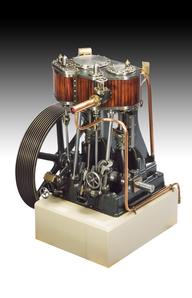

Newcomen Engine built by Francis Thompson of Ashover near Chesterfield 1791. Re-erected in house built with materials taken from the engine house at Pentrich, Derbyshire, where it was last worked
Thomas Newcomen was the first man to design a practical steam engine and with his success an artificial source of copious power became available to replace the uncertain power of wind, water and animals. His invention, more than any other, turned the steady advance of industrial progress into an industrial revolution, by making possible the drainage of deep mines and the full exploitation of the mineral wealth of western Europe. In an age without machine tools or reliable metals Newcomen succeeded because he perceived that he had to conceive an engine in terms of available materials and skills. His engines were built like houses, their cylinders were cast by cannon founders and their boilers, like kettles, generated steam at scarcely more than atmospheric pressure.
The steam was condensed within the upturned cylinder, thus creating a partial vacuum, and it was the pressure of the atmosphere that drove the piston down and, through the rocking beam, lifted the heavy pump rods hanging within the mine shaft. Thus the cylinder was subject to an external pressure and the possibility of its bursting was eliminated.
The theory of the Newcomen engine derives directly from the experiments of seventeenth century scientists. Its construction depended on the older skills of the carpenter, the stone mason, the blacksmith and others. The first engine was erected near Dudley in 1712. The Science Museum engine is a late example, as may be seen by the use of cast iron for the beam, previously made of wood with wrought iron fittings.
Details
- Category:
- Motive Power
- Object Number:
- 1920-124/1
- type:
- atmospheric steam engine
- credit:
- Purchased




